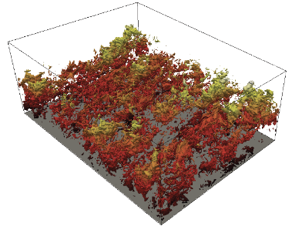A Self-similar Adverse Pressure Gradient Turbulent Boundary Layer
The efficient design and performance of many engineering systems relies on fluid flows remaining attached to aerodynamic surfaces in regions of adverse pressure gradient (APG). Separation of the boundary layer can potentially result in catastrophic consequences or at best sub-optimal performance. Adverse pressure gradients typically arise due to the presence of convex curved surfaces, such as those on wind turbine blades, turbo-machinery and aircraft wings. These configurations are difficult to systematically study, since the pressure gradient applied to the turbulent boundary layer (TBL) is constantly changing in the streamwise direction (Kitsios et al., 2011). There has been a long history of theoretical, experimental and numerical research into TBLs. However, the vast majority of this research has been centred on the zero pressure gradient (ZPG) case, while many aspects of turbulent structure and appropriate scaling of APG TBL remain largely unresolved.
The study of APG turbulent boundary layers (TBL) in an appropriate canonical form is, therefore, of utmost importance to understand the influence of the local pressure gradient. The most appropriate canonical APG TBL to study is arguably one that is self-similar. A self-similar TBL is defined as one in which each of the terms in the governing equations have the same proportionality with streamwise position (Townsend, 1956; Mellor and Gibson, 1966; George and Castillo, 1993, Kitsios et al., 2015). This also indirectly means that the non-dimensional pressure gradient, β, is constant over the domain of interest, where β = 0 for ZPG, β < 0 for a favourable pressure gradient (FPG), β > 0 for an APG, and immediately prior to separation β → ∞. This seminar will present research that we have been conducting towards setting up such a self-similar APG-TBL at the verge of separation using direct numerical simulations and the structure of this flow differs from that of a ZPG TBL

